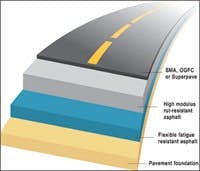New Trends in HMA Technology
The hot-mix asphalt (HMA) industry has renewed its focus on HMA Perpetual Pavement construction, even as novel asphalt mix designs are giving civil engineers and paving contractors new options for constructing both HMA Perpetual Pavements and conventional HMA overlays.
HMA is accelerating its transition from being a reliable, commonplace overlay medium to a sophisticated, versatile, engineered product useful for many different purposes.
"From the ultra-thin HMA gritting mix; to the thin smooth seal preventive maintenance mixes used in Maryland and Ohio; to thick full-depth structural sections used for heavy-duty applications; asphalt can do it all," says Mike Acott, president of the National Asphalt Pavement Association (NAPA).
The industry is pumping prodigious resources into promotion, with Perpetual Pavement at the forefront of the efforts of the Asphalt Pavement Alliance (APA), a coalition made up of NAPA, The Asphalt Institute, and the State Asphalt Associations in 36 states.
Perpetual Pavement is a three-layer pavement design, which should provide pavement life spans of up to five decades, with follow-up asphalt overlays as a sacrificial friction course to continue smoothness.
Perpetual Pavements use multiple layers of engineered, durable asphalt to produce a safe, smooth, long-lasting road, APA says. Most critical is a solid base that resists cracking that could be perpetuated to the surface.
Perpetual Pavement begins with a strong, yet flexible bottom layer that resists tensile strain caused by traffic, and thus stops cracks from forming in the bottom of the pavement. A strong intermediate layer completes the permanent structural portion, and a final layer of rut-resistant HMA yields a surface that lasts many years before scheduled restoration.
"The concept of perpetual asphalt pavements is rapidly gaining acceptance," said the Transportation Research Board (TRB) Committee on General Issues in Asphalt Technology in December 2001. "The idea is to extend the 20-year life expectancies of hot-mix asphalt pavement to greater than 50 years."
To do so requires combining a rut-resistant, impermeable and wear-resistant top structural layer with a rut-resistant and durable intermediate layer and a fatigue-resistant and durable base layer, the TRB committee said. "With these pavements, only periodic surface restoration is necessary, offering advantages in speed of construction (user delay costs) and construction costs," it said.
APA is promoting Perpetual Pavements through technology transfer. Via its website, www.asphaltalliance.com, APA distributes an interactive CD-ROM entitled "What if Roads Could Last a Lifetime?" and a variety of technical papers on Perpetual Pavements.
In spring 1999, the Illinois General Assembly passed legislation that required Illinois DOT to demonstrate construction of pavements designed for a 30-year life cycle. In partnership with private sector interests, IDOT selected a section of I-70 near Casey, Ill., to be reconstructed with an HMA pavement design for 30 years of traffic. In addition to the structural design of the pavement, this section included several new specifications to enhance the performance and durability of the asphalt pavement and concrete bridge structures.
"A 20-mile stretch of I-70 had continuing problems with rutting, and the pavement exceeded its life span," says Steve Lackey, District 5 materials engineering, Illinois DOT. "The asphalt industry brought forth the idea of using extended life concepts on this section."
In this instance, rubblization—the in-place shattering and compaction of the existing PCC pavement as a base course—became part of the project. "The existing PCC pavement was a good candidate for rubblization and the contract was awarded," Lackey says.
And in July 2003, an open house demonstrated these concepts to contractors and agency personnel alike. This pavement showcase, co-hosted by IDOT, the FHWA, and IAPA, attracted DOT and industry personnel from several states and as far away as Ontario. Speakers from IDOT emphasized the series of previous successful rubblization projects in Illinois, including topics of pavement design, material selection, mix design, and rubblization techniques.
In Texas, the Texas DOT continues to apply the Perpetual Pavement approach to major interstate reconstruction projects, having let three additional projects in late 2003. Two of these projects, I-35 in Hill County and I-35 in Webb County, were designed using HMA instead of concrete at least partly due to the successful application of this approach on previous Texas projects, reported the APA.
Another project (SH 114, Fort Worth District) includes segments where a Perpetual Pavement and a thick, continuously reinforced concrete pavement are being constructed where there is extremely heavy truck traffic on a route connecting major aggregate quarries to the Dallas-Fort Worth Metroplex. It will provide an apples-to-apples comparison between the two major approaches that TxDOT is using for "heavy-duty" pavements.
Although today's Superpave is a U.S.-developed product, some of the most innovative improvements in HMA mix technology have migrated from Europe. The latest import from Europe is so-called "warm" asphalt mixes—mixed and placed at temperatures 100F below that considered feasible.
Warm mixes were previewed by U.S. delegates on an international technology scanning tour in 2002, but they were introduced to these shores at the 2003 annual meeting of NAPA.
Immediate benefits of warm mixes include lower costs of fuel required to heat the asphalt mix in production, reduction in asphalt fumes produced, change in the chemical nature of the fumes, and big reduction in emissions from asphalt plants both in volatile organic hydrocarbons (VOCs) and greenhouse gases such as carbon dioxide and water vapor.
Warm mix is possible through three different processes. One involves addition of a synthetic aggregate during HMA mixing, which releases a small amount of moisture that creates a foaming effect in the binder, reducing viscosity and the need for higher temperatures. Another incorporates a foamed hard binder that enables lower mixing temperatures. A third method introduces organic additives with the liquid asphalt to reduce viscosity at mixing and compaction temperatures.
Now warm mixes are being studied to determine if warm mix technology is compatible with U.S. practices, and whether there will be a tradeoff in mix performance. "There are questions about whether the processes and products are compatible with the mix designs, equipment, climate conditions and work practices in the United States," NAPA's Acott said in April. "We must not lose any of the significant performance benefits of SMA, Superpave, or mixtures containing reclaimed asphalt pavement."
In the midst of warm asphalts and Perpetual Pavements, durable stone matrix asphalt is being examined as states such as Maryland and Virginia use performance-graded asphalt binders with SMA design.
SMA is a gap-graded mix, a German import that brings together coarse, durable, premium aggregate with as much as 8 percent liquid asphalt. This high asphalt content contributes to a durable HMA mix with a stone-on-stone structure that readily fights rutting. This stone-on-stone contact develops internal friction and opposition to shear.
States such as Maryland, Virginia and Georgia are setting the pace by melding Superpave design principles into SMA mixes, making a "gap-graded Superpave" that brings together the best of both worlds. Although SMA carries a cost premium over Superpave, new research presented at last year's TRB meeting demonstrated that SMA is more durable than Superpave mixes.
SMA's gap-grading also results in a surface that provides more friction and less noise created at the tire/pavement interface. "Noise reduction with SMA and open-graded friction courses is a big issue for the HMA industry," says Dr. Marvin Traylor, director of engineering & research, Illinois Asphalt Pavement Association. "This is an issue in urban areas where there is opposition to widening highways. Some in the industry are making the point in which we can top the pavement with HMA and lower the decibels to where they've never been before, whether or not a lane is added."
In the meantime, 48 state DOTs permit or require use of Superpave (California and Nevada being the hold-outs). Now, industry attention is turning to educating municipal and county agencies to Superpave's benefits.
"There seems to be a special interest in educating local agencies," Traylor says. "Some local agencies seem to be perplexed about Superpave even as the state DOTs have folded it in and have a lot of expert people.
"But city personnel have to be 'jacks of all trades'. So the amount of information being filtered down on understanding of Superpave is not what we would like," Traylor says. "Now we're starting to focus on helping them understand the terminology and concepts so they can specify Superpave properly and get the best bang for their buck."
Superpave—a registered trademark of the TRB—is a performance-based system of specifications for designing asphalt pavements to hold up to the demands of 100 years. It offers durable pavements that are specifically designed with local temperature extremes and traffic loads in the equation. Superpave designs are providing longer-lived asphalt pavements that will stand up to local climate and traffic volumes at lower long-term costs.
In the 2002 construction season, 4,726 scheduled projects were designed using Superpave procedures. That's about three times the volume in 1998, and some 60 percent of the state HMA projects planned for 2002, says the TRB Superpave Committee. And now that the price differential between conventional Marshall mixes and Superpave mixes is narrowing, the enhanced durability of performance-graded Superpave mixes means that Superpave now is competitive in price.
As these HMA technologies move into the field, performance will be tested. HMA applications will grow, and the product will have transitioned into a true multi-use material.




